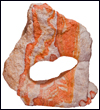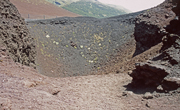Igneous Rocks
Formation
They are called fire rocks and are formed either underground or above ground. Underground, they are formed when the melted rock, called magma, deep within the earth becomes trapped in small pockets. As these pockets of magma cool slowly underground,the magma becomes igneous rocks. Igneous rocks are also formed when volcanoes erupt causing the magma to rise above the earth's surface. When magma appears above the earth, it is called lava. Igneous rocks are formed as the lava cools above ground.
Basalt
 It is a common extrusive igneous (volcanic) rock formed from the rapid cooling of basaltic lava exposed at or very near the surface of a planet or moon. Basalt is usually grey to black in colour, but rapidly weathers to brown or rust-red due to oxidation of its mafic (iron-rich) minerals into rust.
It is a common extrusive igneous (volcanic) rock formed from the rapid cooling of basaltic lava exposed at or very near the surface of a planet or moon. Basalt is usually grey to black in colour, but rapidly weathers to brown or rust-red due to oxidation of its mafic (iron-rich) minerals into rust.
Diabase
![]() It is also known as dolerite and is a mafic, holocrystalline, subvolcanic rock equivalent to volcanic basalt or plutonic gabbro. It is a fine- to medium-grained, dark grey to black intrusive igneous rock. Diabase is usually found in smaller relatively shallow intrusive bodies such as dikes and sills. Diabase dikes occur in regions of crustal extension and often occur in dike swarms of hundreds of individual dikes or sills radiating from a single volcanic centre. This speciem comes from Win Sil, High Force, County Durham.
It is also known as dolerite and is a mafic, holocrystalline, subvolcanic rock equivalent to volcanic basalt or plutonic gabbro. It is a fine- to medium-grained, dark grey to black intrusive igneous rock. Diabase is usually found in smaller relatively shallow intrusive bodies such as dikes and sills. Diabase dikes occur in regions of crustal extension and often occur in dike swarms of hundreds of individual dikes or sills radiating from a single volcanic centre. This speciem comes from Win Sil, High Force, County Durham.
Granite
 These are coarse-grained igneous rocks with a mottled appearance. They comprise a mixture of glassy quartz, white, pink or red alkali feldspar, minor amounts of dark minerals, and often white, sodic plagioclase. Their low density and resistance to weathering means that they usually form high, rugged terrains. The Shap Granite crops out over an area of about five square kilometres in the eastern Lake District. Specimens from the Shap area in North-West England are examples of pink granite. It has an equigranular texture with much pink orthoclase, grey quartz and biotite.
These are coarse-grained igneous rocks with a mottled appearance. They comprise a mixture of glassy quartz, white, pink or red alkali feldspar, minor amounts of dark minerals, and often white, sodic plagioclase. Their low density and resistance to weathering means that they usually form high, rugged terrains. The Shap Granite crops out over an area of about five square kilometres in the eastern Lake District. Specimens from the Shap area in North-West England are examples of pink granite. It has an equigranular texture with much pink orthoclase, grey quartz and biotite.
Lava
 It refers both to molten rock expelled by a volcano during an eruption and the resulting rock after solidification and cooling. This molten rock is formed in the interior of some planets, including Earth, and some of their satellites. The sample in this collection is from Mount Etna.
It refers both to molten rock expelled by a volcano during an eruption and the resulting rock after solidification and cooling. This molten rock is formed in the interior of some planets, including Earth, and some of their satellites. The sample in this collection is from Mount Etna.
Obsidian
![]() It is a naturally occurring volcanic glass formed as an extrusive igneous rock. It is produced when felsiclava extruded from a volcano cools rapidly with minimum crystal growth. Obsidian is commonly found within the margins of rhyolitic lava flows known as obsidian flows, where the chemical composition (high silica content) induces a high viscosity and polymerization degree of the lava.
It is a naturally occurring volcanic glass formed as an extrusive igneous rock. It is produced when felsiclava extruded from a volcano cools rapidly with minimum crystal growth. Obsidian is commonly found within the margins of rhyolitic lava flows known as obsidian flows, where the chemical composition (high silica content) induces a high viscosity and polymerization degree of the lava.
Pumice
![]() It is a light-coloured vesicular igneous rock. It forms through very rapid solidification of a melt. The vesicular texture is a result of gas trapped in the melt at the time of solidification. It looks solid but often floats on water and weighs very little. Pumice is easily crushed and used for abrasive grit or soil amendments. The specimens in the collection came from New Zealand.
It is a light-coloured vesicular igneous rock. It forms through very rapid solidification of a melt. The vesicular texture is a result of gas trapped in the melt at the time of solidification. It looks solid but often floats on water and weighs very little. Pumice is easily crushed and used for abrasive grit or soil amendments. The specimens in the collection came from New Zealand.
Rhyolite
 Also called Volcanic Tuft and Rainbow Rock. Rhyolite began as volcanic ash spewed from the mouth of a volcano millions of years ago. This ash was exposed to high heat and pressure that resulted in turning it to stone. The bright banned colours are a result of exposure to high concentrations of iron oxide. This most unusual wonder of nature has not been altered in anyway except for cutting and shaping the colour and design are completely natural.
Also called Volcanic Tuft and Rainbow Rock. Rhyolite began as volcanic ash spewed from the mouth of a volcano millions of years ago. This ash was exposed to high heat and pressure that resulted in turning it to stone. The bright banned colours are a result of exposure to high concentrations of iron oxide. This most unusual wonder of nature has not been altered in anyway except for cutting and shaping the colour and design are completely natural.

